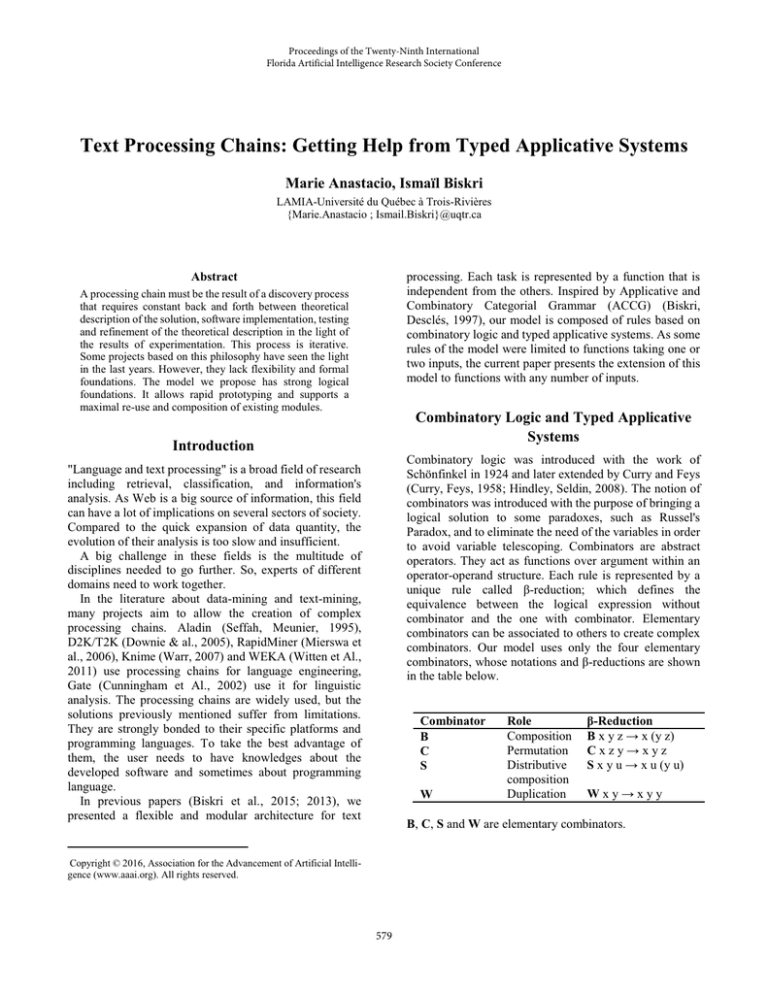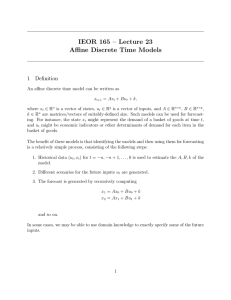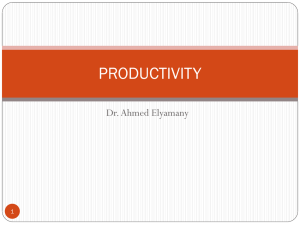
Proceedings of the Twenty-Ninth International
Florida Artificial Intelligence Research Society Conference
Text Processing Chains: Getting Help from Typed Applicative Systems
Marie Anastacio, Ismaïl Biskri
LAMIA-Université du Québec à Trois-Rivières
{Marie.Anastacio ; Ismail.Biskri}@uqtr.ca
processing. Each task is represented by a function that is
independent from the others. Inspired by Applicative and
Combinatory Categorial Grammar (ACCG) (Biskri,
Desclés, 1997), our model is composed of rules based on
combinatory logic and typed applicative systems. As some
rules of the model were limited to functions taking one or
two inputs, the current paper presents the extension of this
model to functions with any number of inputs.
Abstract
A processing chain must be the result of a discovery process
that requires constant back and forth between theoretical
description of the solution, software implementation, testing
and refinement of the theoretical description in the light of
the results of experimentation. This process is iterative.
Some projects based on this philosophy have seen the light
in the last years. However, they lack flexibility and formal
foundations. The model we propose has strong logical
foundations. It allows rapid prototyping and supports a
maximal re-use and composition of existing modules.
Combinatory Logic and Typed Applicative
Systems
Introduction
Combinatory logic was introduced with the work of
Schönfinkel in 1924 and later extended by Curry and Feys
(Curry, Feys, 1958; Hindley, Seldin, 2008). The notion of
combinators was introduced with the purpose of bringing a
logical solution to some paradoxes, such as Russel's
Paradox, and to eliminate the need of the variables in order
to avoid variable telescoping. Combinators are abstract
operators. They act as functions over argument within an
operator-operand structure. Each rule is represented by a
unique rule called β-reduction; which defines the
equivalence between the logical expression without
combinator and the one with combinator. Elementary
combinators can be associated to others to create complex
combinators. Our model uses only the four elementary
combinators, whose notations and β-reductions are shown
in the table below.
"Language and text processing" is a broad field of research
including retrieval, classification, and information's
analysis. As Web is a big source of information, this field
can have a lot of implications on several sectors of society.
Compared to the quick expansion of data quantity, the
evolution of their analysis is too slow and insufficient.
A big challenge in these fields is the multitude of
disciplines needed to go further. So, experts of different
domains need to work together.
In the literature about data-mining and text-mining,
many projects aim to allow the creation of complex
processing chains. Aladin (Seffah, Meunier, 1995),
D2K/T2K (Downie & al., 2005), RapidMiner (Mierswa et
al., 2006), Knime (Warr, 2007) and WEKA (Witten et Al.,
2011) use processing chains for language engineering,
Gate (Cunningham et Al., 2002) use it for linguistic
analysis. The processing chains are widely used, but the
solutions previously mentioned suffer from limitations.
They are strongly bonded to their specific platforms and
programming languages. To take the best advantage of
them, the user needs to have knowledges about the
developed software and sometimes about programming
language.
In previous papers (Biskri et al., 2015; 2013), we
presented a flexible and modular architecture for text
Combinator
B
C
S
W
Role
Composition
Permutation
Distributive
composition
Duplication
β-Reduction
B x y z → x (y z)
Cxzy→xyz
S x y u → x u (y u)
Wxy→xyy
B, C, S and W are elementary combinators.
Copyright © 2016, Association for the Advancement of Artificial Intelligence (www.aaai.org). All rights reserved.
579
Applicative systems represent functions with any
number of inputs and one output. To each operand is
associated a type and each function has an applicative type.
These applicative type starts with "F". Types are defined as
follows:
1. Basic types are types.
2. If x and y are types, Fxy is a type.
For example, if x and y are types, a function having an x
typed input and returning an y typed operand will be of type
Fxy. A function having two x typed inputs and returning a
y typed operand will be of type FxFxy.
This can also be read as: a function taking an x type input
and giving back a function taking an x type input and
returning an y type output.
We use this notation to represent a combinatorial
expression type. For example, if w is an operand that takes
two inputs of types x and y and returning a z typed output,
his type is FxFyz. When we apply the C combinator to it,
we form a new operand Cw of type FyFxz.
The composition combinator B combines two operators
x and y together and form the complex operator B x y that
acts on an operand z.
The permutation combinator C uses an operator x in
order to build the complex operator Cx that acts on the
same two operands as x but in reverse order.
The composition combinator S distributes an operand u
to two operators x and y.
The duplication combinator W takes an operator x that
acts on the same operand twice and form the complex
operator Wx that acts on this operand only once.
We can combine those combinators together to create
complex combinators. For example, we could have an
expression such as "S B C x y z u v". Its global action is
determined by the successive application of its elementary
combinators (first S secondly B and finally C).
SBCxyzuv
B x (C x) y z u v
x (C x y) z u v
xxzyuv
Formal Model
Our model refers to programs as modules. They are
organized in series and as such they form processing
chains. A module acts like a mathematical function that
takes several arguments, process them and return an output.
We are not interested in the internal programming of the
modules but only in their representation as functions and
how they are organized to create processing chains.
The resulting expression, without combinators, is called
a normal form. This form, according to Church-Rosser
theorem, is unique.
Two forms of complex combinators got their own
notation. The power and the distance of an existing
combinator.
Let χ be a combinator. The power of a combinator,
written as a superscript, represents the number of times its
action must be applied. It is defined by χ¹ = χ and χn = B χ
χn-1. For example, the action of the expression W² a b would
be:
A processing chain must respect two rules:
1. The chain must contain at least one module
2. The chain must be syntactically correct
3.
The semantic aspect is user's responsibility.
W2 a b
BWWab
W (W a) b
Wabb
abbb
Our model tends to answer two questions:
x Given a set of modules, what are the allowable
arrangements that lead to coherent processing
chains?
x Given a coherent processing chain, how can we
automate as much as possible its assessment?
The distance of a combinator, written as a subscript,
represent the number of steps its action is postponed. It is
defined by χ0 = χ and χn = Bn χ. For example, the action of
the expression C2 a b c d e will be:
Concretely, a module applies an operation to one or
many entities and returns a new entity. We can therefore
assign an applicative type to it.
C2 a b c d e
B2 C a b c d e
C (a b c) d e
abced
We note the module named M1 of type Fxy as follow:
[M1 : Fxy], and represent it as in fig. 1 . A processing chain
is the representation of the order of application of several
modules on their inputs. To be valid, the type of an input
must be the same as the output linked to it (fig. 2). It also
can be seen as a module itself as it has inputs and output
(fig. 3).
For our model, we represent the type of our
combinatorial expressions with notations taken from
applicative systems.
580
[M1 : (Fx)ny] is a module M1 with n inputs of type x and
an output of type y.
Composition rule
Figure 1 – Module schematisation
[M1 : Fx1...Fxny] + [M2 : Fyz]
---------------------------------------------- Bn
[BnM2M1 : Fx1...Fxnz]
The composition rule is used when two modules are in
series (as in fig. 2). If M1 has n inputs, the power of the B
combinator is n. For these rules, the inputs number of M2
can be more than one.
Figure 2 – Valid chain of two modules in series
Duplication rule
[M1 : (Fx)ny]
-------------------- Wn
[WnM1 : Fxy]
Figure 3 – Processing chain as a new module
The duplication rule transforms a module with n
identical inputs to a module with only one input. It can be
applied only if the chain give the same value to each of its
inputs (fig. 4).
Our model allows the reduction of a processing chain to
this unique module representation. The combinatory logic
keeps the execution order and the rules take type in account
to check the syntactic correctness. To reduce a chain, we
only need the module list, their type, and their execution
order.
The previous model has some limitations. It doesn't
manage with modules with a limited number of inputs. Let
us show these rules :
Figure 4 – Module getting a single value in its three inputs
Permutation rule
APPLICATIVE RULE
[X : x] + [M1 : Fxy]
-----------------------------------[Y : y]
[M1 : Fx1...Fxny]
--------------------------- C
[Cp-1(Cp(…(Cm-2M1))) : Fx1...Fxp-1FxmFxp...Fxm-1Fxm+1...Fxny]
COMPOSITION RULE
[M1 : Fxy] + [M2 : Fyz]
---------------------------------B
[B M2 M1 : Fxz]
DISTRIBUTIVE
COMPOSITION RULE
[M1 : Fxy] + [M2 : FxFyz]
----------------------------------S
[S M2 M1 : Fxy]
The permutation rule allows to change the order of
inputs. It takes the input at position m and moves it to the
position p, with p<m. It's used to reorganize input to make
the other rules applicable.
PERMUTATION RULE
[M1 : FxFyz]
----------------------C
[C M1 : FyFxz]
DUPLICATION RULE
[M1 : FxFxy]
---------------------W
[W M1 : Fxy]
Application of the Approach
In this section, we will show how the rules given in the
previous section are applied and illustrate the reduction of
a processing chain with an example.
Let us consider the linear connection of two modules
(fig. 2). The module [M1 : FxFxy] applies on two identical
inputs of type x and yield an output of type y. The module
[M2 : Fyz] applies on this output to yield an output of type
z. This chain is expressed by the expression: [M1 : FxFxy]
+ [M2 : Fyz]. The composition rule can be applied and
returns the complex module [B2 M2 M1 : FxFxy]. If the
type of M1 output and M2 output where not the same, we
could not have applied the composition rule. So, the
application of the rules is a proof of syntactic correctness
of the chain.
The above rules are only the core set of the previous
model. We will extend the rules so they can be applied to
any number of inputs. To do this we'll need some new
notations.
[M1 : Fx1...Fxny] is a module M1 with n inputs of
different types, input in place "i" is of type xi, and an output
of type y.
581
The module [B2 M2 M1 : FxFxy] can be reduced a
second time with the duplication rule. It is reduced to the
complex module [W (B2 M2 M1) : Fxy].
The permutation rule allows to reorganise the inputs of
a module to apply another rule. Let M be a module with
four inputs of types x, y, z and x and an output of type t :
[M : FxFyFzFxt]. Let X be the value given to the first and
fourth inputs (fig. 5-a). If the fourth was in second position,
we could apply the duplication rule to M. So, we want to
move the fourth input to second position. The permutation
rule returns the complex module [C1 (C2 M) : FxFxFyFzt]
(fig. 5-b). on this new module, the duplication rule can be
applied to get a complex module [W (C1 (C2 M)) : FxFyFzt]
(fig 5-c).
To reduce this chain, we will start with the last module
and process from left to right. So we start with [M5 :
FxFxFyt]. His first input takes the output of [M2 : Fzx].
The composition rule gives a new complex module [B M5
M2 : FzFxFyt] (fig. 7). This new module and [M3 : Fzx]
can be reduced with the distributive composition rule to get
the module [S (B M5 M2) M3 : FzFyt]. (fig. 8). The first
input of this module can be reduced with the composition
rule to get a new module [B2 (S (B M5 M2) M3) M1 :
FxFyFyt]. (fig. 9)
To reduce this module with [M4 : Fzy] we want to use
the composition rule. But to apply it, M4 output must be
the first input of our module. We use the permutation rule
to reorganise the inputs and got a new module [C (C2 (B2
(S (B M5 M2) M3) M1)) : FyFxFyt] (fig. 10). Finally, we
can apply the combination rule that returns the module [B
(C (C2 (B2 (S (B M5 M2) M3) M1))) M4 : FzFxFyt]. As
we have only one module, and no other rule can be applied,
the processing chain is reduced.
(a)
Figure 6 – A complex processing chain
(b)
Figure 7 – Reduction step 1
(c)
Figure 5 – inputs reorganisation
Let us now give the analysis of a somewhat complex
processing chain (fig. 6). This chain is a combination of
five modules.
x
x
x
x
x
Figure 8 – Reduction step 2
M1 of type FxFyz
M2 of type Fzx
M3 of type Fzx
M4 of type Fzy
M5 of type FxFxFyt
582
As the permutation rule is applicable to any module with
more than one input, it is considered separately. This rule
is only used to prepare the module to apply another rule.
For instance, it can be used to group identical inputs in the
beginning to let us apply the duplication rule.
There is two cases of ambiguity. In the first case, we can
apply the duplication rule or the composition rule (fig. 12).
For this case, we will chose to apply the duplication rule
first because the resulting expression is shorter. In the
second case, we can apply the composition rule or the
distributive composition rule (fig. 13). For the same reason,
we will apply the distributive composition rule first.
Figure 9 - Reduction step 3
Figure 10 – Reduction step 4
Figure 12 – Ambiguity between composition and duplication
Figure 11 – Reduction last step
As it has been completely reduced, the processing chain
is considered as syntactically correct. Its combinatory
expression is: B (C (C2 (B2 (S (B M5 M2) M3) M1))) M4.
Using combinatory logic-reductions, we can get the normal
form of this expression.
B (C (C2 (B2 (S (B M5 M2) M3) M1))) M4 Z X Y
C (C2 (B2 (S (B M5 M2) M3) M1)) (M4 Z) X Y
C2 (B2 (S (B M5 M2) M3) M1) X (M4 Z) Y
Figure 13 – Ambiguity between composition and distributive
composition
B2 (S (B M5 M2) M3) M1 X Y (M4 Z)
S (B M5 M2) M3 (M1 X Y) (M4 Z)
The library implements two reduction approaches.
The first approach is the same as the one used in our
previous example. The last module of the chain is
considered as "current module". The different rules are
tested on it and the applicable one is applied. The resulting
module is the new current module, and so on. This
approach is faster and human readable.
The second approach considers all modules
simultaneously and reduces every reduceable module until
none is reduceable anymore. This approach is slower but,
as it reduces every valid sub chain of the processing chain,
it can locate the invalid links inside the chain.
B M5 M2 (M1 X Y) (M3 (M1 X Y)) (M4 Z)
M5 (M2 (M1 X Y)) (M3 (M1 X Y)) (M4 Z)
This form contains the order of application of modules
on their inputs (X, Y and Z).
Implementation and Experimentations
A prototype of the theoretical model was implemented. The
rules are implemented in a F# library and a testing software
in C# language. To implement our model we had to know
if in some cases there were two or more applicable rules.
Each approach has been tested on 22 processing chains
containing 9 syntactically incorrect chains and 13 correct
583
Text analysis is only a modality of the theoretical
framework developed here. It is possible to adapt this work
to other types of data from various disciplines.
chains. The results are shown in table 1 and some of the
reduced chains are shown in figure 14.
VALID
CHAIN
INVALID
CHAIN
REDUCED
NOT
REDUCED
13
0
0
References
Biskri, I., Desclés, J.P., 1997. “Applicative and Combinatory
Categorial Grammar (from syntax to functional semantics)”, In
Recent Advances in Natural Language Processing. John
Benjamins Publishing Company.
Biskri, I., Anastacio, M., Joly, A., Amar Bensaber, B., 2015. “A
Typed Applicative System for a Language and Text Processing
Engineering”. In International Journal of Innovation in Digital
Ecosystems. Elsevier.
Biskri, I., Anastacio, M., Joly, A., Amar Bensaber, B., 2013.
“Integration of Sequence of Computational Modules Dedicated to
Text Analysis: a Combinatory Typed Approach”. In proceedings
of AAAI-FLAIRS’13, St-Pete Beach.
Cunningham, H., Maynard, D., Bontcheva, K., Tablan, V. 2002.
“GATE: A Framework and Graphical Development Environment
for Robust NLP Tools and Applications”. Proceedings of the 40th
Anniversary Meeting of the Association for Computational
Linguistics (ACL'02). Philadelphia.
Downie, J. S., Unsworth, J., Yu, B., Tcheng, D., Rockwell, G.,
and Ramsay, S. J., 2005. A revolutionary approach to humanities
computing: tools development and the D2K datamining
framework. In Proceedings of the 17th Joint International
Conference of ACH/ALLC.
Curry, B. H., Feys, R., 1958. Combinatory logic, Vol. I, NorthHolland.
Hindley, J. R., Seldin, J. P. 2008. Lambda-calculus and
Combinators, an Introduction. Cambridge University Press.
Mierswa, I., Wurst, M., Klinkemberg, R., Scholz, M. and Euler,
T. 2006. “YALE: Rapid Prototyping for Complex Data Mining
Tasks”. In Proceedings of the 12th ACM SIGKDD International
Conference on Knowledge Discovery and Data Mining (KDD
2006), ACM Press.
Seffah, A., Meunier, J.G. 1995. "ALADIN : Un atelier orienté
objet pour l'analyse et la lecture de Textes assistée par
ordinaleur". International Conferencence on Statistics and Texts.
Rome.
Shaumyan, S. K. 1998. Two Paradigms of Linguistics: The
Semiotic Versus Non-Semiotic Paradigm. In Web Journal of
Formal, Computational and Cognitive Linguistics.
Warr, A. W. 2007. Integration, analysis and collaboration. An
Update on Workflow and Pipelining in cheminformatics. Strand
Life Sciences.
Witten, I., Frank, E. and Hall, M., 2011. Data Mining: Practical
Machine Learning Tools and Techniques. Morgan Kaufmann
Publishers.
9
Table 1 – Results of reduction
Figure 14 – Set of reduced chains
Conclusion
The need for flexible, adaptable, consistent and easy-to-use
tools and platforms is essential. But many challenges are
yet to be solved. The user stays in center of its experience
and he can change his mind. The flexibility of the tools is
really important when it happens. Without it, user needs to
constantly go back and forth between theoretical
description of the solution, software implementation,
testing and refinement of the theoretical description in light
of experimentation results. The model that we propose
allows rapid prototyping and support a maximal re-use and
composition of existing modules. It also ensures a firm
compositionality of the different modules in the different
processing chains.
584








